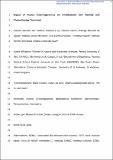Impact of human cytomegalovirus on glioblastoma cell viability and chemotherapy treatment
Abstract
The relationship between human cytomegalovirus (HCMV) and tumours has been extensively investigated, mainly in glioblastoma multiforme (GBM), a malignant tumour of the central nervous system with low overall survival rates. Several reports have demonstrated the presence of HCMV in GBM, although typically restricted to a low number of cells, and studies have indicated that viral proteins have the ability to dysregulate cellular processes and increase tumour malignancy. Treatment of GBM involves the use of the chemotherapeutic agents temozolomide (TMZ) and carmustine (bis-chloroethylnitrosourea, BCNU), which lead to the attachment of adducts to the DNA backbone, causing errors during replication and consequent cell death. It is known that HCMV infection can modulate DNA repair pathways, but what effects the virus may exhibit during chemotherapy are unknown. Here we approach this question by analysing HCMV infection and viral protein accumulation in GBM cell lines with different genotypes and their response to TMZ and BCNU in the presence of the virus. We demonstrate that A172, TP365MG and U251MG GBM cells are efficiently infected by both low-passage (TB40E) and high-passage (AD169) HCMV strains. However, the GBM cell lines vary widely in their permissiveness to viral gene expression and exhibit very different patterns of immediate early, early and late protein accumulation. HCMV reduces the viability of permissive GBM cells in a multiplicity-dependent manner in both the absence and presence of TMZ or BNCU. In sum, we demonstrate that GBM cell lines are equally susceptible but differentially permissive to infection by both low- and high-passage strains of HCMV. This observation not only indicates that viral replication is largely controlled by cellular factors in this system, but also provides a possible explanation for why viral gene products are only found in a subset of cells in GBM tumours. Furthermore, we conclude that the virus does not confer increased resistance to chemotherapeutic drugs in various GBM cell lines, but instead reduces tumour cell viability. These results highlight that the oncomodulatory potential of HCMV is not limited to cancer-promoting activities, but also includes adverse effects on tumour cell proliferation or survival.
Citation
dos Santos , C J , Ferreira Castro , F L , de Aguiar , R B , Menezes , I G , Santos , A C , Paulus , C , Nevels , M & Carlan da Silva , M C 2018 , ' Impact of human cytomegalovirus on glioblastoma cell viability and chemotherapy treatment ' , Journal of General Virology , vol. 99 , no. 9 , pp. 1274-1285 . https://doi.org/10.1099/jgv.0.001118
Publication
Journal of General Virology
Status
Peer reviewed
ISSN
0022-1317Type
Journal article
Description
This study was supported by Fundação de Amparo a Pesquisa do Estado de São Paulo, Brazil (FAPESP); Grant number: 2016/19925-2.Collections
Items in the St Andrews Research Repository are protected by copyright, with all rights reserved, unless otherwise indicated.

